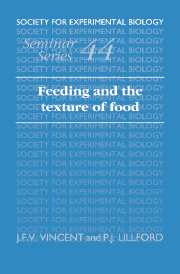Book contents
- Frontmatter
- Contents
- List of contributors
- Introduction
- Mechanical and fracture properties of cellular and fibrous materials
- Texture of plants and fruits
- Measuring meat texture and understanding its structural basis
- Food processing by mastication in cyprinid fish
- Quantitative aspects of the relationship between dentitions and diets
- The control of movements and forces during chewing
- The basic mechanics of mastication: man's adaptive success
- Integrating texture and physiology – techniques
- Brittle textures in processed foods
- The control and generation of texture in soft manufactured foods
- Texture and acceptability of human foods
- Index
Brittle textures in processed foods
Published online by Cambridge University Press: 14 January 2010
- Frontmatter
- Contents
- List of contributors
- Introduction
- Mechanical and fracture properties of cellular and fibrous materials
- Texture of plants and fruits
- Measuring meat texture and understanding its structural basis
- Food processing by mastication in cyprinid fish
- Quantitative aspects of the relationship between dentitions and diets
- The control of movements and forces during chewing
- The basic mechanics of mastication: man's adaptive success
- Integrating texture and physiology – techniques
- Brittle textures in processed foods
- The control and generation of texture in soft manufactured foods
- Texture and acceptability of human foods
- Index
Summary
Processes and products
Brittle products are associated with a wide range of raw materials. In the confectionery area chocolate, toffee and boiled sweets are products which may break at low strains under certain conditions of composition, temperature and strain rate. Brittle potato products include crisps directly produced from the tuber and various snacks produced from the intermediate of dehydrated potato, although cereals offer probably the greatest variety of brittle products from a number of processing operations.
Brittle products are taken here to include the textural terms ‘crisp’, ‘hard’ and ‘crunchy’. An alternative definition of ‘brittle’ may be found in the polymer engineering literature. Powell (1983) characterised brittle failure by the creation of new surfaces and fragmentation after the polymer has deformed to a small extent and Ward (1983) designated brittle behaviour from the stress–strain response as failure at the maximum load which would normally occur at low strains. In contrast ductile behaviour results in a load maximum before failure. Rapid loading tends to favour brittle failure; the implication of the rate of eating in the texture of foods is a further complication.
Composites
Different textures may be produced by the fabrication of composites. Foams represent a special case where the material occupies the foam walls; the lower density of a foam results in reduced stiffness and strength compared to an isotropic solid with correspondingly modified textural properties (see Jeronimidis, this volume). In general, composites make use of components of different properties and it is interesting to note that in synthetic materials engineering inclusions are made in the matrix to toughen or stiffen the component.
- Type
- Chapter
- Information
- Feeding and the Texture of Food , pp. 185 - 210Publisher: Cambridge University PressPrint publication year: 1991
- 3
- Cited by

